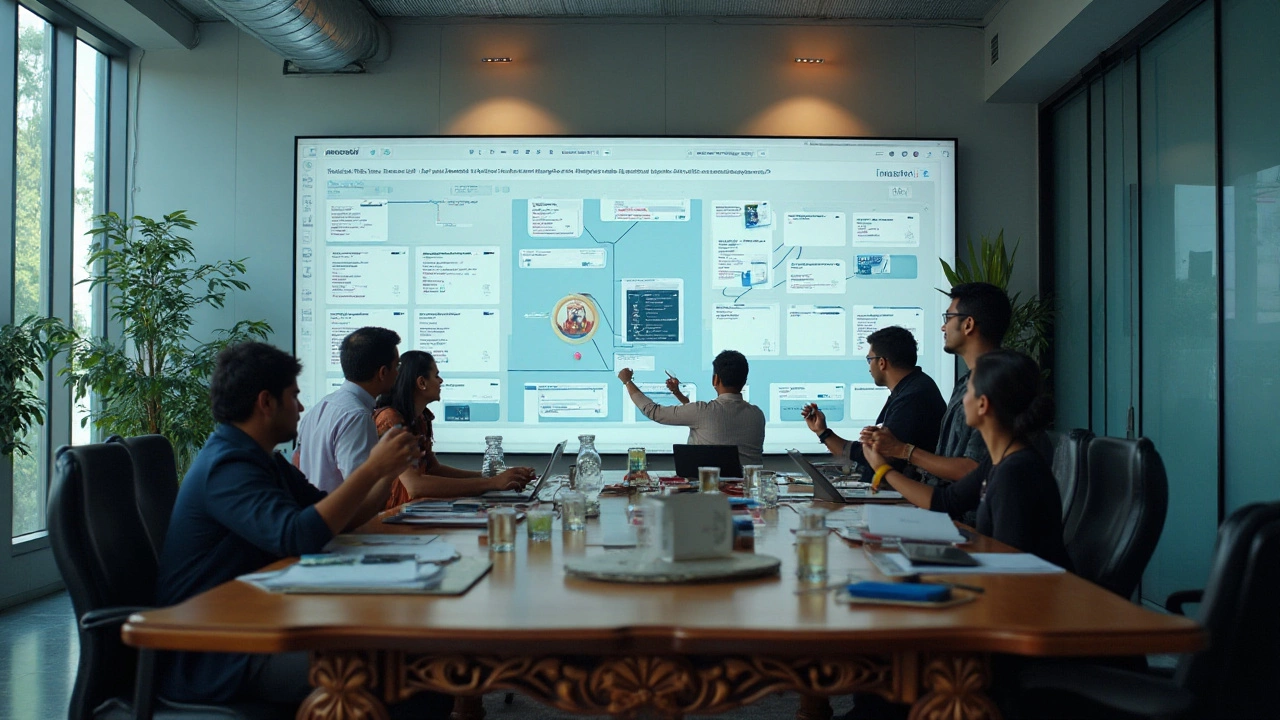Is Figma a UI or UX Design Tool? Understanding Its Role in Modern Design
In the tech-savvy design world, Figma has emerged as a powerhouse, sparking conversations about its true nature. Is it a UI design tool, polished for creating immaculate interfaces? Or does it extend into UX design, emphasizing user journey and interaction? This debate is more than academic; it pinpoints how designers use Figma in various stages of their projects.
Figma offers a suite of features that make it an incredibly versatile tool. With capabilities encompassing both UI and UX design tasks, it encourages seamless collaboration, whether you're sketching out wireframes or refining the final aesthetic touches. Its cloud-based platform allows for real-time teamwork, transforming how designers bring their visions to life.
To truly understand Figma's impact, we need to dissect its elements. From real-world applications to its growth trajectory in the design community, the story of Figma is one of exciting innovation and undeniable utility. Join us as we explore its dual nature, unveiling how it fits into both UI and UX domains.
- Defining UI and UX in Design
- Exploring Figma's Core Features
- How Designers Use Figma for UI
- Figma’s Role in the UX Design Process
Defining UI and UX in Design
Design professionals often talk about UI and UX, but what do these acronyms truly signify? At their core, UI design and UX design encapsulate different but interconnected facets of product design. UI, or User Interface design, revolves around the presentation aspect. It's about crafting visually appealing and intuitive interfaces that guide users' interactions with digital products. From buttons to typography, colors to animations, every visual element plays a part in ensuring clarity and engagement. According to the renowned designer, Don Norman, who is credited with coining the term 'User Experience,' UI is the surface – the tangible part that users touch and see. It's what users initially interact with and where first impressions are formed.
Contrast this with UX, short for User Experience design, which dives deeper below the surface. UX is the process of enhancing user satisfaction by improving the usability, accessibility, and pleasure provided in the interaction with a product. This discipline is holistic, encompassing the entire journey of a user. It includes how questions like, 'Is this product solving my problem?' and 'Is it intuitive to use?' are addressed. A strong UX design ensures that users achieve their goals effectively and enjoyably. As Steve Jobs famously said, "Design is not just what it looks like and feels like. Design is how it works." This quote highlights the essence of UX, which focuses on functionality and the user journey.
The interplay between UI and UX is often visualized as a layered cake, where the UI is the glossy, decorative layer, while the UX is the underlying supportive structure. A product can be beautiful to the eye (UI) but frustratingly complex in its design (UX), and vice versa. This delicate balance is where tools like Figma shine, allowing designers to focus on both UI aesthetics and UX fundamentals simultaneously. In design workshops and studios worldwide, Figma is often touted for its collaborative features that break down these traditional silos, allowing teams to create coherent designs efficiently.
To dispel some myths, consider this insightful breakdown into UI and UX roles. A UI designer might decide on the colors, shapes, and fonts of a website, while a UX designer explores user personas, and maps out storyboards to ensure the site meets the specific needs of its audience. These disciplines require different skill sets, and yet, they must come together seamlessly to craft a cohesive product.
Today's design landscape is constantly evolving, with innovative tools like Figma challenging the traditional separation of UI and UX roles. By understanding the unique contributions of each discipline, designers can approach projects with a more strategic mindset. They can leverage their strengths, create visually compelling and user-centric designs, and ultimately, deliver products that people love to use.

Exploring Figma's Core Features
When examining Figma's comprehensive toolset, it's easy to see why it has surged in popularity across design teams worldwide. The cloud-based nature of Figma allows designers to work from virtually anywhere, collaborating in real-time. The experience is almost akin to editing a shared document, where multiple people can contribute simultaneously without the hassle of version control. This is a game-changer for creative teams, as it fosters an environment where ideas can evolve freely and collaboratively.
Among Figma's most compelling features is its ability to bridge UI design and UX design. It provides a vast library of tools to create sophisticated designs with advanced vector networks, simplified alignment properties, and built-in prototyping capabilities. This seamless integration means that designers can transition from static designs to interactive prototypes within the same platform, significantly reducing the development cycle. It's no surprise that many have praised Figma for streamlining workflows and improving communication between designers and developers.
One of Figma's standout features is its component functionality, which allows users to create and maintain consistent design elements throughout a project. Designers can update a master component, and those changes cascade to all instances where that component lives. This is particularly useful for maintaining a uniform look and feel across complex projects. Moreover, Figma’s library system enables teams to share and source design assets effortlessly, ensuring everyone works with the latest elements.
“Figma's ability to unify the design process under one roof is revolutionary. It fosters creativity and ensures that every stakeholder has the opportunity to contribute meaningfully to a project.” — Design Expert at a Leading Tech Firm
Further adding to its advanced capabilities is Figma's plugin ecosystem. Designers can extend Figma's functionality by incorporating plugins that automate tasks or enhance existing tools. Whether it's for vector manipulation, icon management, or accessibility audits, there's likely a plugin ready to elevate your design process. These plugins open new avenues for customization and efficiency, ensuring that every design process is as compelling and efficient as possible.
Interestingly, an August 2023 survey of design tools usage showed Figma leading in preference among design professionals, with 68% citing it as their primary tool for both gathering feedback and refining ideas. This is a testament to the platform's usability and its focus on both UI and UX elements.
Another innovative feature that Figma offers is its integration with various platforms and tools. From Slack to Jira, the ability to incorporate Figma into existing workflows simplifies the collaboration process and ensures seamless communication across various platforms. This integration capability reflects Figma's commitment to modernizing the design process, making it a favorite among tech-savvy design professionals.

How Designers Use Figma for UI
Figma has transformed the landscape of UI design, making it more dynamic and collaborative than ever before. Designers appreciate the ability to create detailed wireframes and prototypes efficiently. Thanks to its intuitive vector network, designing complex interfaces becomes a task of simplicity rather than frustration. One of the standout features that makes Figma particularly attractive is auto-layout, which lets designers maintain consistent spacing between objects, maintaining a smooth, uniform appearance across multiple design instances.
What sets Figma apart is its cloud-based nature. This feature has changed team dynamics, enabling designers to collaborate in real-time, regardless of physical location. Teams working across continents find this particularly beneficial as they can edit and provide feedback instantly, reducing the time traditionally spent on revisions and approvals. The incorporation of live comments means designers and stakeholders can express their thoughts directly on the design file, improving clarity and reducing misunderstandings.
In the realm of UI, Figma's component system is a game-changer. It empowers designers to create reusable elements that maintain consistency across multiple screens or projects. Not only does this save time, but it also ensures a coherent visual language throughout an application. Designers often refer to this system when creating design systems, which formalize the UI components and interactions that teams will use, promoting efficiency and unity. Moreover, integration with libraries allows designers to share their component sets with others, fostering creativity and consistency across different design teams.
"Figma’s auto-layout and real-time collaboration features have redefined modern UI design," says Emily Zhang, a renowned full-stack designer, highlighting Figma’s role in streamlining design processes and enhancing collaboration.
One cannot overlook the broad range of plugins available within Figma, which extend its functionality significantly. These plugins simplify routine tasks like asset export and prototyping, making them quicker and less prone to error. Designers have access to color palette generators, content placeholders, and vector art collections, all of which can be integrated directly into a design. This rich ecosystem transforms Figma from a mere design tool to a complete workflow solution.
Responsive web design, crucial in today's multi-device world, is another area where Figma shines. It allows designers to preview how their designs will adapt to different screen sizes, ensuring a seamless experience across devices. This responsive nature is essential for modern UI designers who need to consider the end-user experience extensively. Interactive prototypes can be shared with clients or team members to visualize these responsive layouts, offering a more tangible feel of the final product before a single line of code is written.

Figma’s Role in the UX Design Process
When we dive into the realm of UX design, Figma stands out not just for how it enables the creation of aesthetically pleasing designs, but for how it plays a transformative role in shaping user experiences. At the core of UX design is the idea of creating products that provide meaningful and relevant experiences to users. This involves a careful balance of user research, wireframing, prototyping, and usability testing. Figma, with its robust features, integrates each of these crucial steps, making it not just a tool, but a hub for enhancing the complete design process.
One of Figma's most significant contributions to the UX design process is its real-time collaborative environment. This feature is a game-changer as it allows designers, developers, and stakeholders to work simultaneously on projects. Collaboration, often a bottleneck in traditional design settings, is seamless and instant with Figma. Designers can share their work with a single click, enabling teams to gather immediate feedback. Using shared libraries and components ensures consistency across projects, saving time and fostering innovation.
Intuitive prototyping is another pillar where Figma shines. It offers tools not just for static designs, but for creating dynamic, interactive prototypes that mimic actual user interactions. By simulating real-world behavior, designers can foresee potential user pain points and address them before development begins. This iterative process not only elevates the user experience but also reduces costly reworks. A Figma statistic highlights that teams using its prototyping feature witness a 40% reduction in design discrepancy issues, streamlining the development cycle.
"Figma has transformed how we iterate on UX design, significantly cutting down our time from concept to testing," remarks Emily Ng, UX Lead at a renowned digital agency.
Beyond prototyping, Figma supports accessibility checks, ensuring that designs are inclusive and cater to a diverse user base. Designers can integrate plugins that simulate visual impairments, test color contrast ratios, and assure compliance with accessibility standards. This proactive approach means avoiding last-minute remediation and delivering a universally accessible interface from the onset.
Figma’s role in user research shouldn't be overlooked. Its capacity for creating and organizing design systems enables UX researchers to conduct A/B testing seamlessly. By utilizing components and variants, different versions of a design can be tested effortlessly to determine which performs better with users. Statistics derived from Figma-driven studies are often displayed in interactive dashboards, providing stakeholders with clear, actionable insights. A notable point from a study revealed that 72% of projects that integrated Figma directly into the UX process reported higher user satisfaction scores.
In the fast-evolving world of user experience, leveraging tools like Figma is not just beneficial but necessary for staying ahead. Its multifunctional platform not only aids in crafting user-centered designs but also fosters innovation through collaboration, experimentation, and inclusion. In the dance of design and user experience, Figma is both the conductor and the stage, offering tools and space for creativity to thrive and evolve.





